|
APRIL 2021
|
|
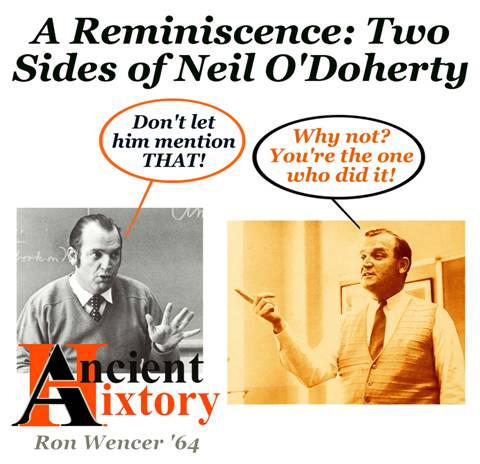
|
|
Foreword
|
If you attended Hicksville
High between the late 1960s and 1980, you knew of the English
Department's Neil O'Doherty (1933-1980).
He was outspoken, gregarious, at times verbally pugnacious, and
so persistent about teaching philosophy that he finally got to launch an
official Introduction to
Philosophy class in the 1970s. For
readers who never knew him, this last fact may be misleading, so I shall
balance it by disclosing that Neil was equally well known for
befriending student athletes, and - at least in his earlier years in
town - aggressively playing pick-up basketball with them in the summer
heat.
His high school students probably knew Neil O'Doherty
better than I did; in fact, I was never officially his student at all.
But of the many people from whom I have
learned, Neil was the one whose words first let me see that everything
we are taught "fits in," that it is life's connections that lead
to real understanding. That
poetry, philosophy, and the arts reflect the same reality.
That truth matters.
I first met him while watching a Comets
basketball game circa December 1963, and I last saw him on a spring
afternoon in 1965. During
that time, I was one of a large handful of students, most of them
members of the HHS class of 1964, for whom he led a series of discussions not
connected with any school curriculum (although he was then on the
faculty of the Junior High).
It began with an introduction to Epistemology
- was this the seed from which his Introduction
to Philosophy later sprouted?
In 1964, I got used to seeing two very different
aspects of Neil. At his best
(I thought), he was contemplative,
admiring the thought processes of great philosophers.
At other times, he was militant, ardently debating, reveling in his own defense of truth as
he knew it. I could not
always reconcile the two Neils back then.
Can I do that now? Well,
at least I can understand them better, for I no longer am seventeen, and
I know more of what Neil knew then.
I never did get to know what he thought of Bob Dylan's writing,
but invoking these words seems appropriate at this point:
"We'll meet on edges, soon," said I, proud 'neath
heated brow
Ah, but I was so much older then, I'm younger than that now
I hope in a subsequent article, perhaps in June, to
present others' thoughts of Neil, collected from students and if
possible, some people who taught alongside him.
In that vein, I welcome input from readers.
Please feel free to email your thoughts and recollections of him
directly to me at WencerHix@gmail.com
For now let's get going, first looking at some of the
things that went into making Neil what he was.
A
Passionate Teacher
I wanted to list this quality first.
I recognize that many things mattered to him - family, cultural
identity, politics, religion, poetry, and all the rest - and that, at
a given moment he might have said that any one of them was the most
important part of his life. But
as far as I saw, day after day, around the clock, he was consistently
passionate about teaching young people, and shepherding them in whatever
way he could. Many people I
knew, including other gifted teachers, cared, but for Neil, caring about
those whom he taught was a vocation.
His teaching (some may have thought of it more as coaching) was not
limited to classrooms. I
first experienced it over pizza in the Alibi,
after watching a dreadful basketball game go the wrong way.
I experienced it on a weekend afternoon as I helped wash his
'63 Ambassador sedan.
I can imagine that others experienced it playing half-court
basketball sessions in a sun-baked schoolyard.
I doubt that I ever knew another teacher who sought out and
pursued so many out-of-classroom opportunities to teach.
Irish
(duh)
Yes, believe it or not, Neil O'Doherty was Irish.
He was not once-a-year "Hey, look at my green hair!" Irish; he was Irish at his core, and
he bled green.
I think that the family into which he was born differed fundamentally
from many Irish-American families, who were too far removed from the Old
Sod to feel the old wounds keenly. The
O'Doherty ancestors had weathered the Famine of the nineteenth century
without emigrating. His
parents left their homeland for
America
only after first living through the grim times of the 1916 Easter
Rebellion. Judging by Neil,
I suspect that his siblings all felt the scars of
Ireland
's history.
In the 1960s, typical Irish-Americans his age might grow vaguely
sentimental when listening to Bing Crosby's de-politicized version of
the ballad
Galway
Bay
.
Neil, in contrast, would let loose his tenor vocal chords with God
Bless Ireland, an in-your-face anthem from the Easter Rebellion era
that dangles in front of its listeners the vision of a British noose -
as bait, daring them to rise up and risk martyrdom.
The Irish pain which he felt went back past the Rebellion, even
past the Famine. I recall
his voice's quivering as he spoke of the torture inflicted upon Irish
patriots by Cromwell's forces, during the seventeenth-century Conquest
of Ireland.
Neil's being Irish was not always about suffering and grief.
He could demonstrate pride, as when he compared the respective
abilities of contemporary world-stage tenors Enrico Caruso and John
McCormack, or while objectively praising a poem by William Butler Yeats.
Although a devout Catholic, at times Neil showed little
respect for the Irish-blooded Americans (most of them descended from
Famine immigrants) who had risen to the upper tier of the country's
Roman Catholic clergy. For
example, he invariably referred to Francis J. Spellman, then Cardinal
and Archbishop of New York, simply as Fat
Frank.
Conservative
|
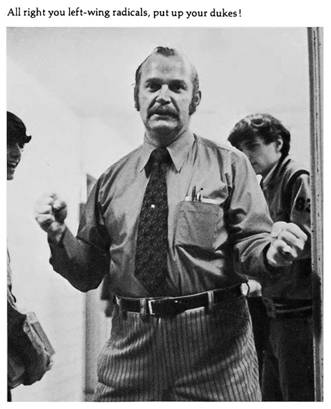
|
|
Mugging
for the 1972 Comet Yearbook
|
|
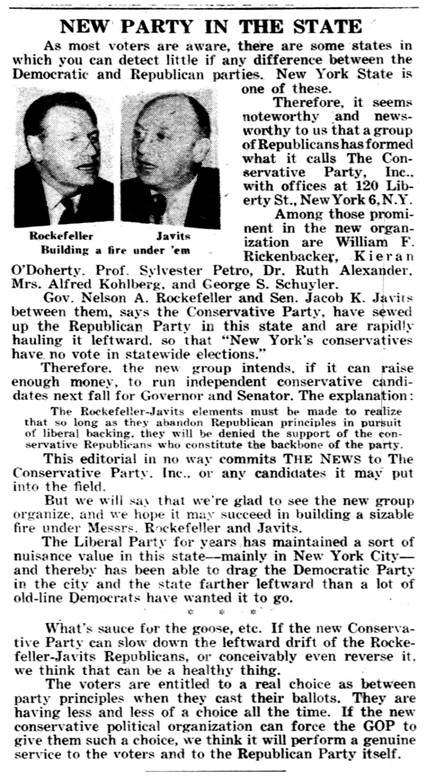
|
|
Editorial,
New York
Daily News
February
26, 1962
|
In 1962, four New Yorkers met in the
Queens
home of Neil's parents, and established the Conservative Party of New
York. Among the four were
Neil's brother Kieran O'Doherty (eldest of Neil's generation),
their sister Kathleen, and her husband, J. Daniel Mahoney.
The party they founded that day went on to impressive and swift
success. It soon garnered
more votes than the once-powerful Liberal Party, relegating the latter
to a lower position on the ballot. In
1970, James Buckley, a Conservative Party candidate, would win a seat in
the U.S. Senate.
|
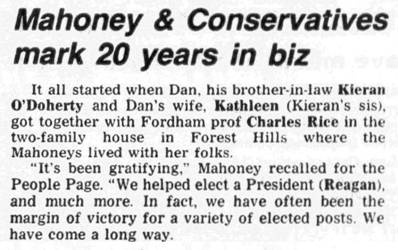
|
|
New
York
Daily News
December
6, 1982
|
|
*
|
Catholic
As the earlier reference to Fat Frank suggests, Neil's attitude towards Catholicism could be
quirky.
He was a traditionalist. His
unshakeable faith was bolstered by his studies, specifically the
theological roots that took hold in the Early Christian era and grew
stronger during the medieval period.
He subscribed without question to the teachings embodied in
formal Papal Encyclicals (a series of Popes' open letters, begun in
1740, which elaborate upon the Church's teaching in the light of
contemporary issues).
I suppose that his faith was what led him to
philosophy. He took great
joy from reading and discussing the writings of Thomas Aquinas - medieval
philosopher, theologian, Doctor of the Roman Catholic Church, and Saint
- specifically the arguments based on the Metaphysics
of Aristotle.
The 1960s brought new ideas and external changes to Roman Catholicism.
Neil was uncomfortable, critical, and skeptical.
He was certain that the core of his belief would not change, but
he understood humanity well enough to know that changes can lead to
fads, and that fads distract people.
Instead of trying to better understand church doctrine, and
figuring out how to meet people's needs in the 1960s, people might get
caught up in worrying about rotating an altar 180 degrees, or how to fit
a "church-in-the-round" arrangement of altar and pews into an old
boxy church building. I
often heard Neil dismiss such concerns as Pollyanna-Kiss-Your-Neighbor
Catholicism.
Ready
to Laugh
I was surprised by some of the things which he found funny.
Neil would reminisce about practical jokes from his Army days,
some of which seemed as feeble as short-sheeting someone's bed at
summer camp. On the other
hand, I recall two people whom he and I both found genuinely funny.
The first was Hillaire Belloc, a prolific writer,
member of British Parliament, brilliant debater, and man of great
stamina (e.g., Belloc once walked all the way from the U.S. Midwest to
northern California, earning his room and board along the way by drawing
portraits of his farmer hosts, and by reciting poetry).
Among Belloc's many, many witty verses are
Pale
Ebenezer thought it wrong to fight
But Roaring Bill (who killed him) thought it right.
and
Here
richly, with ridiculous display,
The Politician's corpse was laid away.
While all of his acquaintance sneered and slanged
I wept: for I had longed to see him hanged.
The second person whose work we both enjoyed was a
performer known as Lou Carter.
He was the creation of someone in the music business, at the time
rumored to be an arranger or a jazz musician.
Onstage or on television, he would dress as a 1940s cab driver,
and perform the songs he supposedly had written between his shifts in
the cab.
|
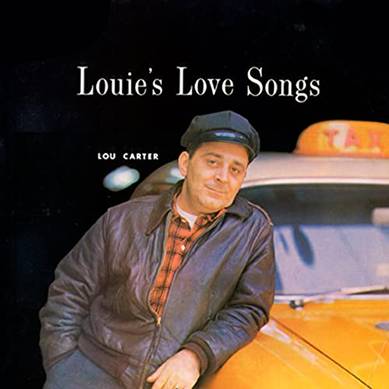
|
|
amazon.com
|
What mattered most about the songs were the lyrics,
which exhibited an exceptional flair for the use and abuse of language.
Neil's favorites included If
I had a Nose Full of Nickels and the incomparable Lost
Elbows. The latter
builds in a crescendo, and concludes with the haunting words "until
my elbows... are back... in my arrrrrrmms."
A
Debater
If people believe in absolute truth, and believe that
they know some piece of it, they will ardently defend their belief
against anyone who does not share it.
That was Neil.
Adept in debate, he was not above showboating, and could get carried
away in the heat of however long a moment a debate gave him.
He took perhaps too much pleasure in (to use one of his favorite
words) decimating opponents.
Woe unto the foes who debated Neil unprepared, or were not nimble
enough defend their own positions as Neil changed tactics.
Among Neil's supporters, such people might become known as
"intellectual lightweights" or "peanut pushers" (i.e., people
whose minds lacked the fitness to deploy weighty arguments).
I've always wondered why such debates seem significant.
After all, to be a great debater does not make one a great
thinker, anymore than being a great actor makes one a great playwright.
Thomas Aquinas did not earn Neil's respect for coming up with,
say, a five-minute metaphysical argument on the spot - he spent years
in research and thought. Aquinas
is known for constructing arguments that could persuade those who held
opposing viewpoints, not for trouncing them in debates, and leaving them
flattened like Wiley Coyote under an anvil.
|
***
|
|
O'Doherty
Contemplative
|
Truth
and Logic
Neil O'Doherty found the arguments put
forth by Aristotle and Aquinas so elegant, clear, and persuasive that
they illuminated the path he walked for as long as he lived.
In the brief time in which I knew him, he concentrated more on
what they said than on the history by which Aquinas came to know the
works of a man born more than sixteen centuries before he was.
Neil did say, however, that Aquinas came to understand Aristotle
in part through the writings of Averroës and Avicenna, whom Neil
described as Arabian philosophers. How
did that happen?
|
*
|
|

|
|
Moses,
Oxford, Ashmolean Museum
,
(Program
for The Year 1200 Exhibition)
collection
of Ronald A. Wencer
|
The
Year 1200
Unexpectedly, I found the answer when I
attended an exhibition - The
Year 1200 - at the Metropolitan Museum of Art in 1970.
On display were medieval objects from a number of the world's best collections.
No matter where in Europe they originated, all the objects shared
a new curvilinear style. Why?
Clues to the answer to both questions lie in the history of Europe in
the twelfth century. After
Islam took hold in the Middle East, Arabs carried it to many
Mediterranean shores. In
North Africa, the Moors - a conglomerate of many ethnicities, in which
Arab seemed predominant - had grown strong.
Crossing to the Iberian peninsula, they had established An-Andalus,
a Muslim kingdom, in the year 711. It
would endure for almost 800 years.
At times, An-Andalus was at war with nearby Christian nations, but at
other times there was peace and tolerance.
The decades that led to the year 1200 belonged to one of the
latter periods, and during these years, educated European Christians and
Andalusian Moors became more aware of each others' cultures, including art and
architecture.
Learning
Revived
The earlier collapse of the Roman Empire,
including its network of ancient libraries, had cost Western Europe
dearly. Monks and other
Christian scholars had lost access to (among other things) the writings
of the great ancient Greek thinkers.
The Dark Ages soon earned their name.
|
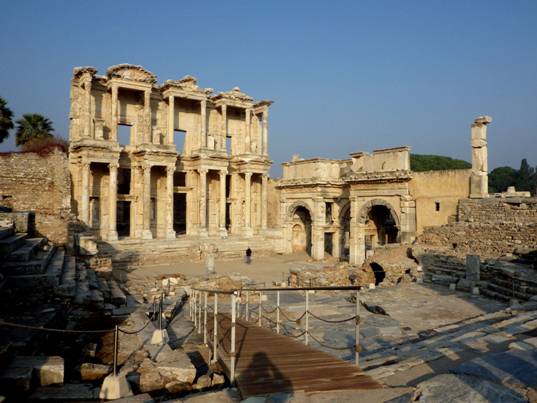
|
|
Ruins
of the Library of Celsus at Ephesus, third largest library
in the Roman Empire; it was destroyed in the third century,
likely by two events: Gothic invasion and earthquake
photograph
by Ronald A. Wencer
|
As the centuries progressed into medieval
times, the standard caricature of a Western scholar became that of a
wanderer, who hoped against hope to someday find forgotten old
manuscripts in some obscure place.
In the East, meanwhile, Islamic holy writings (including the Qur'an)
told Muslims that Jews and Christians also had been favored by God, and
that as People of the Book, they warranted respect.
Parts of the Alhambra, the Moors' citadel in Granada, tangibly reflect that
idea.
|
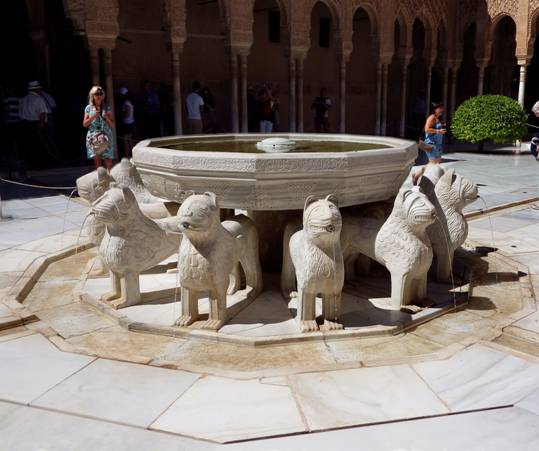
|
|
Courtyard
in Muhammed V's Palace of the Lions in the Alhambra
Per
the 'People of the Book' concept, each lion
in the fountain represents one Tribe of Israel
photograph
by Ronald A. Wencer
|
Arabs, like the Romans, revered learning,
and the writings that mattered to the other Peoples
of the Book mattered to them as well.
As Christian scholars in the West bewailed the loss of the
ancient texts, Arab scholars were seeking the same texts in the East,
finding them, studying them, and making faithful copies of them (usually
in Arabic) in new centers of learning.
The old network of Roman libraries was being supplanted by a new
network of Arabic libraries.
Scholarly
Toledo
By the eleventh century, the Iberian city
of Toledo had become one of these centers of learning, crammed with
educated people who were fluent in Greek, Roman, and Arabic.
When the Moorish Empire was at peace with Europe, word of
Toledo's wealth of knowledge, and especially its collection of ancient
manuscripts, spread quickly. Given
the Church's pent-up demand for ancient writings, Toledo's
multi-lingual scholars were in high demand.
Below are the words of one twelfth century Canon (i.e.,
a member of a religious community which followed a code of conduct,
often modeled on rules put in place by St. Augustine); he is known today
simply as Canon Mark.
|

|
|
excerpt
from
The Arabic Impact on the Western World
by Marie-Thérèse d'Alverny
published in
The Year 1200 II: A
Background Survey
|
Canon Mark originally had wanted to study medicine, but
he was so gifted with respect to languages that translation became his
calling within the Church. Some
years later, his Bishop would call upon him to translate the entire Qur'an
into Latin, so that Catholic clerics could better understand Islam.
Aquinas:
a More Complete Picture
It took nearly a hundred years to translate all of Aristotle's
surviving works into Latin, and to create sufficient copies for the
Christian monastic libraries. Sometimes,
along with the Greek's own words, the manuscripts included scholarly
commentary by Arabic thinkers - a cause of much study and debate among
Catholic theologians. This
period of debate - rarely face-to-face arguing, but instead exchanges
of well-reasoned written ideas - was the time in which Aquinas lived,
studying first in Naples and then in Paris.
He had the great benefit of being able to read the original Metaphysics,
and also the Muslim commentaries made on it by Avicenna (a Persian of
the early eleventh century) and Averroës (an Islamic Spaniard of the
twelfth century), in Latin, a language with which he was thoroughly
familiar.
The giants of history are said to stand upon the shoulders of earlier
giants, and Aquinas is often thought of as standing upon the
shoulders of Aristotle. Fair
enough. But Neil O'Doherty
always made certain to also mention the Arabic commentators, men who in
some ways lifted Aristotle's shoulders even higher for Aquinas.
Think about that. Thomas
Aquinas, whose thinking is fundamental to the Catholic Church, and who
is considered a Saint, underpinned some of his metaphysical arguments
with the ideas of a pagan philosopher, after first reading
interpretations of them by Muslim scholars.
Imagine what it must have been like for Neil O'Doherty to first learn
this tale. He never would
have accepted the idea that Islam in any sense superseded Catholicism as
a religion - yet he knew that an ancient Greek had been the first to
lay bare an important kernel of truth, that Islamic philosophers had
protected and nurtured that kernel, and that a Dominican monk had
cultivated it further. This
quest for truth had transcended people, beliefs, and cultures.
Neil would have been gobsmacked.
Words, whether poetry or philosophy, could render Neil
O'Doherty humble before the brilliance of the person who wrote them,
could inspire him, could anger him, or could just make him laugh.
In terms of poetry, I remember best his reading aloud
Chesterton's poem Lepanto, a
wonderfully rhythmic historical narrative.
It was as if the flavor of each word lingered deliciously on his
palate after it was spoken. Lepanto
recounts how the naval forces of an alliance of Christian nations fought
the powerful fleet of the Ottoman Empire.
The cadence of the words carries the listener the length of the
Mediterranean, determinedly riding the swells and falling into the
troughs in between.
The
Ottoman Empire and the Battle of Lepanto
The Ottomans rose to power in fourteenth century Turkey.
Within a century and a half, their rule had spread through
southeastern Europe, the Arabian peninsula, and across north Africa from
Egypt to Algeria. They
defeated the powerful Byzantine Empire, turning the Christian city of
Constantinople into the Islamic city of Istanbul.
Their forces were fierce, converting defeated Christians by force
into Muslims, much as their empire converted the huge Cathedral
Church of Holy Wisdom into the Hagia
Sophia Great Holy Mosque. The
generous respect for Christians and Jews shown by the Moors at the Alhambra
does not come to mind when thinking of the oft-brutal Ottomans.
In 1571, the Ottoman Empire threatened to expand further, and Western
Europe worried. A Holy League of nations assembled a fleet to send against it, led by
Don John of Austria, half-brother of the King of Spain.
Much to the Muslims' surprise, the League
was victorious; what remained of the Ottoman fleet scurried back home.
Although the battle proved to be a turning point in the long run,
the Ottoman Empire would remain a force for another three centuries and
more.
The situation, like Chesterton's poem, seems
tailor-made for the militant part of Neil's nature.
It was a good guy vs. bad
guy moment in Western history: an underdog younger brother, leading
the fight for a people who believe in truth, defeats an oppressive foe.
One can imagine Neil admiring Don John's victory, and perhaps
sometimes even thinking that his own little victories in debate
continued the same never-ending battle.
Not
Decimated
Lepanto was a tipping point; though defeated, the
Ottomans would continue to thrive.
Neither their power nor their empire was destroyed.
In fact, they still had their heroes.
At Lepanto, one of them was a lesser admiral named Ali Pasha (note that this was a common name, one sometimes adopted
by Westerners who had been forced to convert to Islam).
As defeat loomed, the Ottoman forces had begun to panic, but this
man assumed command where his superiors could not.
He organized an orderly retreat, thereby saving many Ottoman
ships and lives. Back home,
his efforts were acknowledged, and he went on to have a long and
celebrated naval career. Eventually,
he was named Chief Admiral of the Empire, and to his name was added the prefix Kılıç
(which means Sword).
|
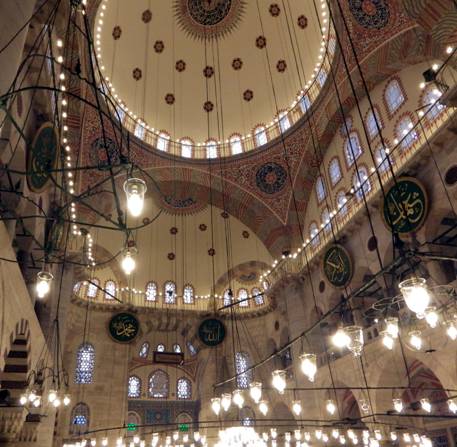
|
|
Interior
of Kılıç Ali Pasha Mosque, Istanbul
photograph
by Ronald A. Wencer
|
When he was old, in gratitude for all the successes
granted to him during his lifetime by Allah, Ali Pasha commissioned the
construction of a beautiful mosque.
Four and a half centuries later, it still stands in Istanbul,
perpetuating his name. Tourists
like me come from all over the world, walk inside, and have their breath
taken away.
This post script to the battle suggests that Lepanto seemed a bigger
success for Europe than it seemed a defeat for the Ottoman Empire.
The latter dialed down its ambitions, and missed a step or two,
but it kept on going.
Conclusion
Militancy is always so clear; contemplation is always
so muddy and ambiguous.
Did the Neil who read Chesterton's wonderful poem believe that Lepanto
had for all time ended the conflict between two peoples who followed
different truths? What of
the Neil who paid homage to Thomas Aquinas for the many tranquil months
(or years) that the monk spent forging a single philosophical argument
from the writings of an ancient Greek, Muslims, and other Catholics?
The view of history that we learned in high school was often simplified:
the Middle Ages were followed by the Renaissance, then by the
Reformation, then by the Industrial Revolution, etc.
It only seemed clear-cut because so many complications had been
stripped away.
The real world is never like that. Through the distance of time, the
life of Muhammed V, who built his palace in Granada with little Stars of
David and crosses worked into the windows and walls, seems rather
serene. In reality, his
reign was beset with tumult. He
was deposed; the usurper was later murdered by a second usurper, who in
turn was beheaded by a Christian enemy - all of which allowed Muhammed
V to regain his throne. Much
of his era did not reflect the noble and peaceful ideals shown in his
work.
The same can be said of the era in which Aquinas pondered theology and
philosophy: during those decades, wave upon wave of Crusaders and
Saracens were slaughtering each other in the East.
|

|
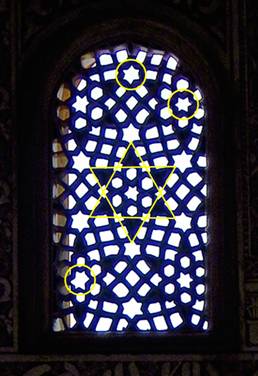
|
|
Oratory
at Nasrid Palace, The Alhambra
In
this Islamic prayer room, each upper window's geometric decor
forms many six-pointed stars, some of which are highlighted in
the
enlargement. A large
star sits in the center; the area around it
contains twelve smaller stars, symbolic of the Tribes of Israel.
photograph
by Ronald A. Wencer
|
What
was a man like Neil, who believed both in quiet contemplation and
fighting the good fight, to do? Perhaps
in teaching poetry and philosophy, he found bridges to the idealized
medieval realms through which his mind wanted to roam.
|
***
|
|

|
|
Extracted
from the 1980 Comet Yearbook
|
|
*****
|
Following
Up
With further input, other perspectives of Neil O'Doherty will be
presented here in a month or two. I
hope to hear from you about him.
|












